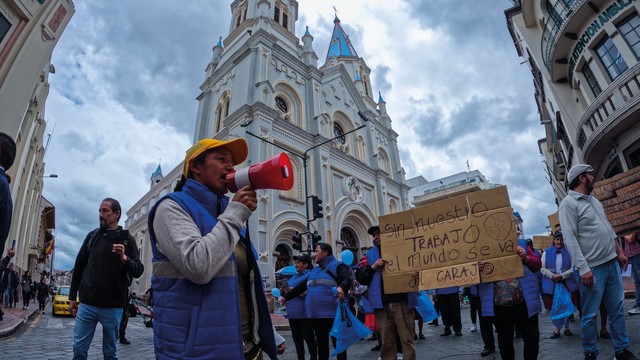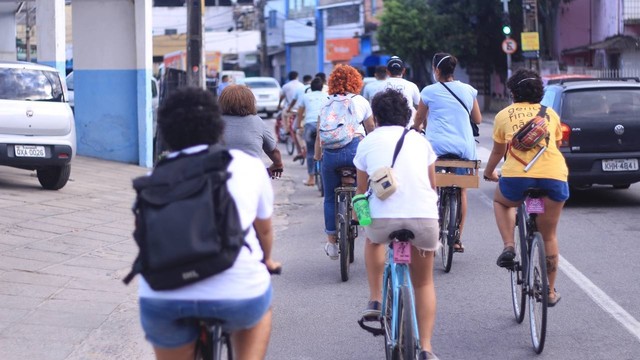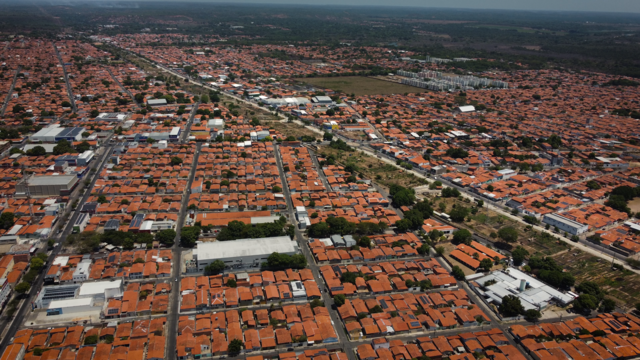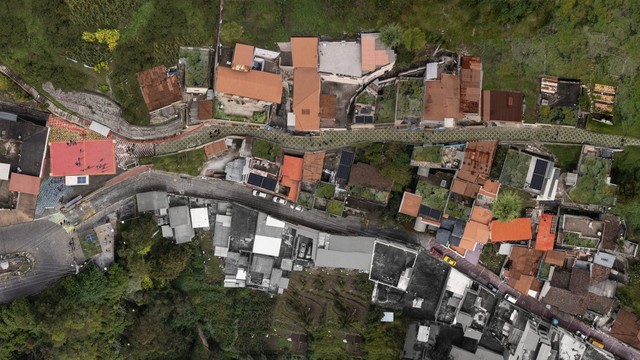Building low-carbon resilience into Freetown’s future
As a rapidly urbanising coastal city with high levels of deforestation, Freetown is increasingly vulnerable to the effects of climate change. To address these challenges Freetown’s City Council has launched a climate action strategy to strengthen resilience and reduce carbon emissions, building on such initiatives as the ‘Freetown the Treetown’ community tree planting programme to restore the city’s ecological infrastructure.

Informal settlement in Cockle Bay, Freetown (Photo: Paul Simpson/DPU UCL, via Flickr, CC BY 2.0)
Freetown, Sierra Leone’s capital city, has experienced rapid urbanisation over the past 50 years. While there is some contestation about what constitutes an informal settlement (slum) in Freetown and therefore a lack of certainty about the percentage of Freetown’s population residing in these areas, studies suggest somewhere between 60% and 75% of urban areas in Freetown should be considered as slums.
Freetown has experienced rapid deforestation as a result of this growth, which has led to significant ecological and climate vulnerabilities – evidenced by such events as the mudslide in 2017 that killed more than 1,000 people and left 3,000 homeless.
Freetown’s mayor, Yvonne Aki-Sawyerr, who was elected in 2018, sought to address these critical challenges head on with the Transform Freetown agenda and subsequent development plan, and the ‘Freetown the Treetown’ initiative. This scheme seeks to restore the city’s ecosystem, while also empowering residents and providing income to communities, and climate finance to make tangible long-term positive change across the city.
Setting ambitious afforestation targets, the city is working to integrate participatory nature-based solutions into the city’s climate adaptation and mitigation plans as well as more formal local planning to make the city much more resilient in the future.
The 2023 Freetown climate action strategy was developed through engagement with multiple partners, including residents and communities, to ensure that it was co-created by the people of Freetown, with targeted community engagement to factor in the needs of each neighbourhood and zone across the city. Freetown is already experiencing significant climate impacts that need urgent responses, and the plan is striving for a low-carbon, resilient and inclusive future.
Eric Hubbard, senior technical advisor, City of FreetownMany development challenges are being deeply exacerbated by climate change – like the level of informality in the city with 60% of people living in and around informal settlements – which creates a high level of vulnerability. The slum upgrading process is tied to the regeneration of the coast line; a classic example of a new development trajectory that is climate sensitive
Freetown: history and context
Freetown is a coastal city surrounded by tree-covered hills. The city’s population has increased tenfold in the past 50 years to 1.2 million people and it continues to grow. This rapid growth has pushed the city up into the hinterlands and put pressure on the forest. The civil war in Sierra Leone (1991-2002) also had a significant impact.

The intense rainfall that hit Freetown on August 14, 2017 triggered a massive mudslide and flash flooding (Photo: Mark Stedman, via Wikimedia Commons, CC BY 2.0)
Trees have been felled to make way for housing, and to provide fuel for cooking. Seventy per cent of Freetown’s trees have been felled and it is estimated that since 2011 some half a million trees are lost annually. According to Freetown City Council, 60% of all people in the city live in or around informal settlements, although some estimates put the figure as high as 75%.
Dwellings are also being built on extremely marginal and vulnerable land, such as coastal areas and river beds. Only 5% of the city has access to mains water, so poor waste and water management are creating further flooding risks. This immense pressure on the ecological system has had serious knock-on effects, increasing the vulnerability of these communities.
Freetown is rainy and the tree cover provides important stability to the area’s ecosystems – holding water and preventing runoff. The lack of tree cover impacts the soil and causes erosion. In August 2017, more than 1,100 people died as the result of a mudslide caused by three days of torrential rainfall. A further 3,000 people were made homeless.
Following this tragedy, in 2018, the newly elected Mayor Yvonne Aki-Sawyerr committed to ‘transform Freetown’ and initiatives have subsequently been implemented to realise a vision for the city that encapsulates climate-resilient development and which could be transformative for the people of Freetown and their livelihoods.
One particular initiative – Freetown the Treetown – has been particularly engaging and building on this momentum Freetown has recently developed its first climate action strategy, which will run to 2030.

Residents of Freetown planting trees as a part of the Freetown the Treetown project (Photo: UrbanShift, via Flickr, PDM 1.0)
It is a response for a city that is already experiencing significant climate impacts that can improve housing and land use planning, at the same time as increasing resilience and achieving lower-carbon development for all vulnerable people across the city. This city profile describes the actions taken to date and the process of developing and implementing the plan.
Transform Freetown
The Transform Freetown agenda was a participatory process to understand the community priorities for the city and to develop a plan for realising the vision
“In August 2018, a comprehensive needs assessment of residents’ views of service delivery was undertaken through 310 meetings which were held at zone level," according to Freetown City Council. "This is the first time a city-wide consultation of this scale, captured service-level resident satisfaction data for the purpose of developing a strategy. The development strategy that became Transform Freetown was informed by meetings attended by ward committee members, various community stakeholders, councillors, youth groups, religious groups, women’s groups, and was facilitated by 500 trained facilitators.”
Four clusters were identified against which priority actions could be mapped: resilience, human development, healthy city and urban mobility. Three working groups composed of a broad selection of stakeholders were established to formulate plans and targets against these clusters.
Additional engagement with communities took place to ensure people were actively involved in the planning process – including through the city council website and Facebook page, one-to-one meetings, an open-door policy and a community walkabout programme. The outcome was 19 clear targets and 37 initiatives to be delivered by 2022. A particularly ambitious goal was to increase vegetation cover across the city by 50% on 2018 levels by 2030.
Freetown the Treetown
Freetown the Treetown, the flagship programme for the city to restore and improve its ecological infrastructure, was designed to be locally led by communities. Under the scheme, city residents are paid to plant, nurture and monitor trees and mangroves throughout the city. Setting a target to plant a million trees by 2022, 50 tree species were grown in a nursery and have subsequently been planted by volunteers across the city. Participating in the scheme is a four-step process.
First, a member of the community plants and photographs a tree and then logs it in the Freetown Treetracker app. Once a quarter, trees that have been logged are verified, growers are paid and the trees are placed on a public map and geotagged so their survival can be monitored digitally.

Residents of Freetown planting trees as a part of the Freetown the Treetown project (Photo: UrbanShift, via Flickr, PDM 1.0)
At this stage a ‘token’ is created for the verified tree to give it a value. which goes into Freetown’s digital wallet, from where it can go into a market and be sold to create revenue to fund the programme. Attaching value (the ‘token’) to each tree has provided an income for a household to look after that tree in the community where the reforestation is happening.
Freetown is creating a market for reforestation to fund the trees’ growth and support further planting. The goal of planting one million trees has been expanded to five million trees by 2030 and 20 million by 2050, but sustainable finance is required to meet these goals and people need to be incentivised to continue to engage with the programme.
Some have raised concerns that planting so many trees may not be possible in this time frame due to the topographical constraints and the numerous cemented compounds in the city.
So it is important that these schemes are capable of scaling and that nature-based solutions are recognised for their value, and are adequately resourced.
Climate action strategy
Flowing from the strategic priorities that emerged from the Transform Freetown process, and as a member of the C40 Network, the next step for the city was to develop a climate action strategy (a requirement of membership of the C40 network). Freetown’s first climate action strategy 2022-2030 (PDF) was released in January 2023.

Freetown Mayor Aki-Sawyerr sensitising community members during the 2023 Beat the Heat campaign to cool and clean the city's airscape (Photo: copyright Eric Hubbard)
Rain and heat are significant challenges for Freetown, and understanding how these affect the people, especially those in the most vulnerable places, was a priority. Flooding, landslides, heat stress and water shortages are exacerbated by the city’s high levels of informality, which are likely to worsen as a result of climate change.
But the climate action strategy expanded the Transform Freetown approach beyond water, heat and trees to look at all the sectors that are vulnerable to climate change, and also the sectors that need to decarbonise. So by engaging with the stories of people in the communities across Freetown, it was possible to understand what this vulnerability looks like and what people’s priorities are in addressing these challenges.
The process for creating the strategy was similar to that used to develop Transform Freetown, ie engaging with representatives of every sector, the national government and the people of Freetown. Speaking directly to communities and residents in the planning process ensured that the strategy reflected the aspirations of the communities but was also something that the government could achieve with the resources available.
Freetown’s local government has been resourceful and capitalises on many international partners for both facilitation and implementation of its objectives. And while there is not a significant level of detail about the engagement process in the strategy, there are some examples of activities that fed into its development.
These include a workshop organised by UrbanShift in June 2022 that brought together 50 stakeholders, including community leaders, for the Freetown Strategic Planning Lab. The lab’s workshops and site visits enabled participants to discuss the challenge of climate risks and managing urban growth in the city with a view to identifying priority actions and propose solutions to the issues they had discussed and witnessed.
The city council officers working on climate didn’t have climate experience, but drawing on insights from C40, through strategic support and funding from other international partners, and learning from others through networking and utilising the community’s resources meant that the plan was informed by work in other cities on building low-carbon resilience. The city council established the Climate Action and Disaster Risk Unit upon launching the strategy as a dedicated resource for managing its implementation.
The climate action strategy sought to understand where major sources of emissions were in Freetown and, focusing on adaptation, put in place an overall strategy that could look at mitigation too. Freetown’s mitigation strategy is essentially an adaptation strategy – because its central focus is to continue to build out ecological infrastructure across the city in the most vulnerable spaces and to work with residents throughout the city to envision a future that is equitable across every vulnerable community within the context of climate change.
The strategy does set an emissions reduction goal for the city: Freetown commits to reduce greenhouse gas emissions by at least 44% by 2050 compared to the base year (2018) level and an interim target of 13% below base year levels by 2030.
Underpinning this target are some key areas where Freetown aims for lower carbon development. For example, transitioning to a clean, accessible and equitable city energy system is highlighted as a priority area in the plan (PDF) and actions to achieve this vision include:
- Developing CBD solar-powered street lighting
- Developing a programme that includes providing solar panels for electricity generation in PHUs in Freetown
- Conducting a feasibility assessment of clean cooking solutions for Susan’s Bay
- Implementing programmes to deliver clean cooking solutions at household level in informal communities, and
- Promoting a minimum energy efficient performance standard for existing buildings and regulations for minimum energy efficiency requirements for new buildings.
The focus on ensuring that the same strategic priorities that run through the development plan also underpin the climate strategy is significant, demonstrating clear integrated thinking for long-term solutions. And building on the momentum of community engagement in both Transform Freetown and Freetown the Treetown in delivering the plan is important.
People continue to co-create and inform developments, and this empowerment can enable successful outcomes for the city, in terms of resilience, but also in terms of improving livelihoods and prosperity for the people of Freetown.
The strategy is intended to be a living tool for the residents of Freetown to use in their daily lives to make more sustainable choices to help the delivery of the city’s vision.
Looking ahead
Freetown will continue to work with its residents on implementing the climate action strategy, and will review and update the strategy on a five-yearly basis. It needs the resources and capacity within the city administration to ensure that the actions can be realised.
The climate action strategy was framed in the context of Sierra Leone’s Nationally Determined Contribution and the National Adaptation Plan, however Freetown has recognised that climate change requires immediate, comprehensive responses. The sense of urgency coming from the city – which is already experiencing significant climate impacts – means that things are developing much faster at the local/city level than they are nationally.
Traditionally, climate change has not been a city council issue in Sierra Leone, as it was regarded as a national policy area. New ground is being trodden in Freetown, so looking ahead, there is a need for more alignment between what is happening nationally and locally.
Further reading
- Freetown’s first climate action strategy 2022-2030 (PDF)
- Transform Freetown, an overview 2019-2022 (PDF)
- Freetown’s highly replicable way of self-financing urban reforestation, C40 case study (May 2022,)
- Mayor’s Desk: Cultivating Climate Resilience in Sierra Leone, Lincoln Institute of Land Policy (November 2022)
- Freetown: options for growth and resilience (PDF), World Bank (2019)
- Beyond formal and informal: understanding urban informalities from Freetown, Cities (October, 2020)
Author

Dr Karen Barrass (karenlouisebarrass@gmail.com) is founder of Climate Insights
Frontrunner cities forms part of the Transformative Urban Coalitions (TUC) project, funded by Germany's Federal Ministry of Economic Affairs and Climate Action



